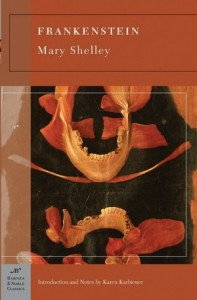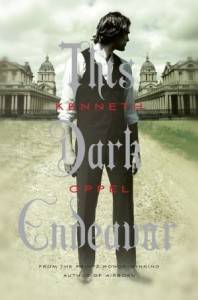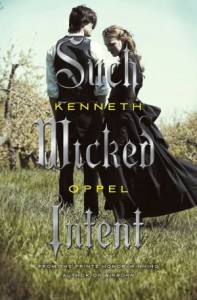

That Something Else is a presence previously unsuspected, bigger and wilder and totally Other than oneself. It could be the devil, or it could be God. The terror that overcame Abraham in Genesis 15:12 and made the Israelites tremble at Mt. Sinai was perfectly good, but also perfectly Other—the word for it is Holy. The unholy Other is also a source of terror, but of a different kind, the kind that will drag a soul to hell. Some of us don’t see the flames behind the image; we only see the power and lust for a share of it. That’s another aspect that distinguishes the terror story: the victim is to some degree complicit in his own victimization. For example, I would classify The Exorcist as a horror story, but Rosemary’s Baby belongs more to the terror category. Both involve some form of demonic possession, so what makes the difference? Mainly this: the victim of possession in The Exorcist is blameless; but Rosemary’s husband and neighbors, and Rosemary herself at the end, are complicit. That’s what makes the terror genre even more chilling, in my opinion, than horror. But I also think the value of terror for readers is greater.
Frankenstein, or the Modern Prometheus, by Mary Shelly, is a perfect example. The origins of the story are well known: in the summer 1816, Mary Wollstonecraft, her lover (soon-to-be husband) Percy Shelly, and their child William traveled to Geneva to visit Lord Byron at his villa on Lake Geneva. After an evening of reading ghost stories to each other, Byron suggested that every member of the party try writing one. All gave up soon after beginning, except for Mary, who wracked her brains trying to come up with a suitable plot. Late one night it came to her like a vivid dream:
I saw the pale student of unhallowed arts kneeling beside the thing he had put together. I saw the hideous phantasm of a man stretched out, and then, on the working of some powerful engine, show signs of life, and stir with an uneasy, half vital motion . . . Swift as light and as cheering was the idea that broke upon me. “I have found it! What terrified me will terrify others.”
Opinions vary as to whether the novel is even readable today, with its complex, multiple-framed structure characterized by points-of-view nested like Russian dolls. But the story itself has powerful resonance in the human imagination, its title resurrected in different forms several times every year (as in the “Frankenstorm”–aka Hurricane Sandy–of 2012). The monster, especially in its Boris Karloff manifestation, is recognized everywhere in the world. When a story creates its own frame of reference, there’s always a reason–even if the references get all mixed up, like attaching the name “Frankenstein” to the monster rather than the creator.


Kenneth Oppel, This Dark Endeavor (2011) and Such Wicked Intent (2012). Simon & Schuster, about 315 pages each. Age/interest level: 14-up.
Lake Geneva, ca 1816. The inseparable twins, Victor and Konrad Frankenstein (Wait a minute! you might be thinking; Victor didn’t have a—He does now. Just read on.) live a privileged life as the oldest sons of a respected magistrate. Their mountain chateau on Lake Geneva brims with music, stimulating conversation, and high spirits—owing to the twins, their younger brother William, their bookish friend Henry Clavel, and their beautiful cousin Elizabeth. Henry writes the scripts for their amateur theatricals, one of which is in progress as the story opens. It’s a potboiler involving dragons and treachery, which hints at the sturm und drang (storm and stress) to come.
A rivalry simmers beneath the twins’ togetherness, soon to be thrown into high relief by Konrad’s sudden illness. Every cure sinks him lower; in desperation, Victor seeks help from Julius Polidori, a disgraced apothecary but actually an alchemist. By translating an ancient text found in the Frankenstein’s “dark library” (a secret chamber in the family chateau), Polidori discovers the three vital ingredients for the Elixir of Life—each one fiendishly difficult to obtain. Victor, Elizabeth, Henry, and even Konrad (when he temporarily recovers) are launched on a classic quest filled with danger, passion, rage, lust, exhilaration, and hairbreadth escapes: in short, all the elements of a perfect gothic storm.
Some of these elements may be objectionable to parents, especially Victor’s growing desire for Elizabeth. Not surprisingly, she is attracted to Konrad, to whom she’s secretly engaged (even though they’re only sixteen). There are a few eyebrow-raising passages on that theme, though not graphic and nothing that will take the average 16-year-old reader by surprise. Another possible objection is the occult angle, with a particular emphasis on secret knowledge. This is true to the original novel, where Victor is pictured in his late teens as obsessed with unlocking all the secrets of life and science. What Oppel adds is motivation: first to save Konrad’s life, and then (sorry for the spoiler) to bring his brother back from death in the second book. Along the way Victor loses faith in everything, including his loving but flawed father; he determines to become his own creator, and “move heaven and earth to see my brother again.” If this were a horror novel, fear would dominate him, but he’s not motivated by fear of death so much as a lust for power over death.
For all the melodrama, the story raises good questions about the boundaries between life and death and who is in control. Elizabeth, a pious Catholic, is certain God is in control; religious discussions with the skeptical Frankensteins occur regularly at the Chateau. But her flesh battles with her spirit: “Just because one has feelings doesn’t mean one has to act on them . . . Do you know what distinguishes us from animals? . . .They know only instinct. No knowledge of right and wrong. They have no self-control. Humans do. And we’re meant to exercise that control.”
Victor doesn’t take instruction very well, because his greatest enemy is himself. Genuine love for his brother clashes with jealousy and covetousness, sometimes within minutes. His interior struggle suggests Paul’s in Romans 7: “For I do not do what I want, but I do the very thing I hate.” Victor will go to amazing lengths to supply the magical elixir, but has the capacity to unto it all in a moment with a sword in his hand. Wretched youth! There is no one to rescue him from his body of death.
Konrad’s temperament is bland in comparison, the vital yin to Victor’s yang. Their conflict in the first book is resolved rather suddenly by the end, but as the second book opens, with the old alchemical texts blazing in a bonfire, we know the old lusts and ambitions will flame again. For the conclusion of volume two, Oppel borrows a scene from Shelly’s novel in which lightning strikes a tree before Victor’s eyes. Such astonishing power, he 

This Dark Endeavor, with its classic three tasks and shape-shifting adversaries, is a page-turner. Such Wicked Intent is restricted mainly to four characters and a limited setting, with a lot of back-and-forth between one place and another–it feels claustrophobic at times. The overblown style of both books can be off-putting: “I tried but could not meet his eye, so ashamed of him was I.” Or, “I smile to myself. We will see how long she can resist me.”
Just because a book is “scary” or touches on the occult doesn’t mean it’s devil’s bait. In reasonable quantities and with a suitable context, such literature can warn away as effectively as it might seduce. To be obsessed with horror, or even terror as I’ve defined it here, would be unhealthy, but most obsessions are unhealthy. The metaphysical themes of Frankenstein lead naturally to metaphysical comparisons, such as contrasting Victor’s loathing of the monster he finally creates with God’s persistent love for His own creatures. As Mary Shelly hints, and as Kenneth Oppel’s version shows, Victor’s monster originates within. And the only possible remedy is without.
Stay Up to Date!
Get the information you need to make wise choices about books for your children and teens.
Our weekly newsletter includes our latest reviews, related links from around the web, a featured book list, book trivia, and more. We never sell your information. You may unsubscribe at any time.
Support our writers and help keep Redeemed Reader ad-free by joining the Redeemed Reader Fellowship.
Stay Up to Date!
Get the information you need to make wise choices about books for your children and teens.
Our weekly newsletter includes our latest reviews, related links from around the web, a featured book list, book trivia, and more. We never sell your information. You may unsubscribe at any time.
FREE Bible Guide!
Get a guide to the Best Bibles for Children and Teens. Perfect for an Easter gift.
We'd love to hear from you!
Our comments are now limited to our members (both Silver and Golden Key). Members, you just need to log in with your normal log-in credentials!
Not a member yet? You can join the Silver Key ($2.99/month) for a free 2-week trial. Cancel at any time. Find out more about membership here.
3 Comments
Leave a Comment
You must be logged in to post a comment.


I really like the distinction you’ve made between terror and horror, Janie. I completely agree. That is so helpful; I’ve often tried to explain to people why I like some books and not others, even though they may appear similar on the surface. You’ve hit the nail on the head! I’ve wanted to the Oppel book for a while. Must move it closer to the top of the (giant) pile 😉
Thanks, Betsy. It’s a distinction that I don’t know if anybody else has made, so I don’t know how relevant it is. Glad it’s helpful to some.
thanks for this post, from it is was able to find this….The Last Dragonslayer by Jasper Fforde
Thanks again.